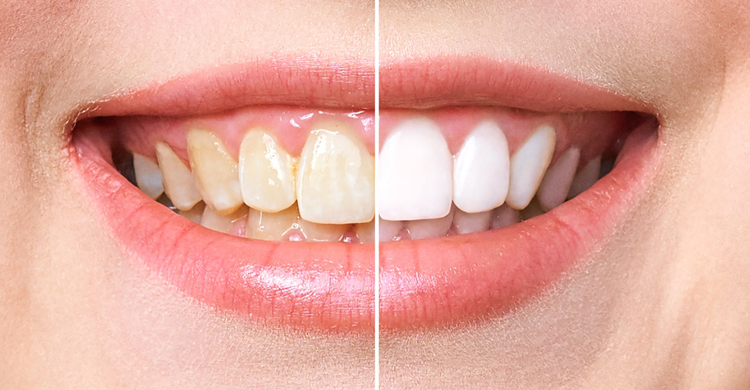
Blog Posts
RECENT BLOG POST


04 Aug 2021


10 Aug 2021


10 Aug 2021


By Dr. Aastha Chandra

08 Feb 2022
INFORMATION ON TEETH WHITENING
Teeth whitening is one of the most popular cosmetic dentistry treatments offering a quick, non-invasive and affordable way to enhance a smile. If maintained properly, the results can last to upto 1 year.
There are various teeth whitening options available depending on varying concentrations of peroxide and varying application times:
1) In-Office Whitening :-
A major advantage of getting an in-office whitening done is that you can achieve a significant shade change in a very short period of time. This protocol involves the carefully controlled use of a relatively high-concentration hydrogen peroxide gel (9-40%). This is applied to the teeth by the dentist after the gums have been protected with a barrier. Generally, the peroxide remains on the teeth for several 15 to 20 minute intervals that add up to an hour (at most).
2) Whitening Trays :-
In this case, the dentist takes special impressions of your teeth to make customised, fitted trays for you. These are flexible in nature. These trays have to be loaded with the whitening gel, carbamide peroxide which has about a third of the strength of hydrogen peroxide. The fitted trays ensure bleach stays in close contact with the teeth for best results, prevent saliva from diluting the bleach, and minimize the amount of bleach that can leak out and possibly irritate the gums. Over-the-counter trays do not fit the teeth precisely, leading to leakage of bleach and sensitive gums.
Tooth bleaching products are either stored in syringes and added to trays before use, or pre-loaded into the trays.
3) Whitening Strips :-
One of the most popular ways to whiten teeth is with teeth whitening strips. These are made from a thin, flexible plastic and coated with a low concentration of bleaching product. The strips are pre-packaged and placed on the teeth, easily conforming to the shape of the teeth. They can be worn while doing other activities, and when the application time is up (usually about 30 minutes) they are discarded. Most are used twice daily for two weeks.
Strips are generally less effective than custom-fitted trays because saliva can seep under the strips and dilute the bleach. Strips may not be long enough for a wide smile, and they often slip out of place.
4) Whitening Toothpastes :-
Toothpastes contain mild abrasives such as silica, aluminum oxide, calcium carbonate, and baking soda, which help remove surface stains. Whitening toothpastes do not contain bleach like professional whitening products, but they usually contain extra polishing or chemical agents that can help remove additional surface stains thus getting your teeth only one shade lighter. They do not help with removal of deep-set stains. Whitening toothpastes may also be more abrasive and may cause wearing out of the enamel, if used for a longer period of time.
5) Over-The-Counter Products :-
Whitening products available over the counter consist of whitening kits with bleaching gels which have a concentration lower than the one dispensed by the dentists. The gel is applied to the teeth via one-size-fits-all trays, strips or paint-on applicators. In many cases this may only whiten a few of the front teeth unlike custom trays that can whiten the entire smile.
Post Operative Instructions Aafter Teeth Whitening :-
1. Give your lungs a break. NO SMOKING for 48 hours.
2. Avoid staining foods and beverages (for eg. red sauce, berries, boxed juices, coffee, tea, wine, etc.)
3. You may be mildly sensitive to hot or cold liquids and foods. This is temporary and lasts for a day or two. If sensitivity persists beyond 48 hours, we recommend taking OTC medication for pain or de-sensitizing paste such as Sensodyne.
4. DO NOT sip with a straw as it may aggravate the sensitivity.
5. If you experience gum sensitivity, DO NOT brush the affected area.
6. Immediate whitening results can be quite dramatic due to minor dehydration of your teeth. It is normal for the colour to tone down a notch post treatment once the teeth rehydrate.
7. Long-term results vary from patient to patient. This can depend on the original shade of your teeth and include habits such as smoking or drinking colored beverages.
8. You may need a touch up every 6-12 months to retain the colour.
9. Existing fillings, crowns, bonding, etc., will not whiten. Therefore, these may need to be changed in order to match your NEW SMILE.
Am I A Candidate For Whitening?
Tooth whitening is safe for most people and the best candidates are those who only have mild to moderate discoloration. But there are certain types of discoloration that cannot be corrected by whitening treatments, and there are certain dental or medical conditions that may reduce the chances tooth whitening will work for you. These include:
1) Porcelain veneers, dental crowns, caps, fillings, or dental bonding on the front teeth. These synthetic materials do not respond to bleaching products. You may need new crowns or veneers if you want these teeth to appear whiter.
2) Yellow teeth usually bleach well, however brown teeth may not whiten as much. Teeth with gray tones, white spots, or discoloration from a “dead” tooth may not bleach at all.
Some Conditions May Become Worse If Teeth Are Bleached :-
Sensitive teeth or teeth with worn enamel, and patients with bruxism (grinding or gnashing of teeth) or temporomandibular joint disorder (TMJ/ TMD). In-office whitening procedures may be able to be performed in some cases with these conditions.
Tooth whitening is not effective if tooth discoloration is caused by medications or a tooth injury.

